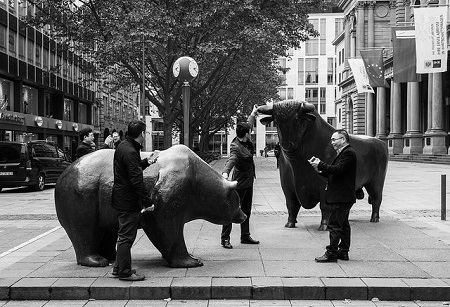Bull and Bear Market Definition for Stock Market Trends

Difference between bull and bear market explained with simple definition as another investment terms in stock market investing.
Do you know the difference between bull market and bear market? Let us talk another investment terms that are commonly used when investing in the stock market. In InvestmentTotal.com, we don’t only talk about how to invest money in the stock market, we also discuss different words like bull market and bear market so that we can easily understand our subject matter.
Let us first define what is a bull market and then we will give definition to bear market. Let us find out when investors become bearish and bullish. Before we will talk about the difference between bull and bear market, let us define the meaning of the two. If you know how to read market trends, you are already familiar with the term “bull and bear market”.
Bear
“Someone who believes or speculates that a particular security, or the securities in a market, will decline in value. Investors are “bearish” when they view stocks as being in sustained decline”
Bull
Someone who believes that a particular security, or the securities in a market, will increase in value. Investors are “bullish” when the view stocks as being on the upswing.
Difference Between Bull and Bear Market
Why is it Called Bear Market?
“A bear market is a market in which a group of securities falls in price or loses value over a period of time. A prolonged bear market may result in a decrease of 20 percent or more in market prices. A bear market in stocks may be due to investors’ expectations of economic trends; in bonds, a bear market results from rising interest rates.”
Image Credit: Andre Douque on Creative Commons 2.0 via Flickr – Taking the bear, I mean the bull by the hornsTourist attraction at Frankfurt stock exchange
Why is it Called Bull Market?
“A bull market is a long period of rising prices of securities usually by 20 percent or more. Bull markets generally involve heavy trading and are marked by a general upward trend in the market, independent of daily fluctuations. Example: from 1982 to 2000 American investors enjoyed two lengthy bull markets, one lasting from 1982 through 1990 and the other lasting from 1992 through 2000.”
Bull and Bear Market explained by Brian O’Connell in his book Build Your Own Mutual Funds – How to Use a Personal Portfolio to Take Control of Your Financial Life” on page 232-234